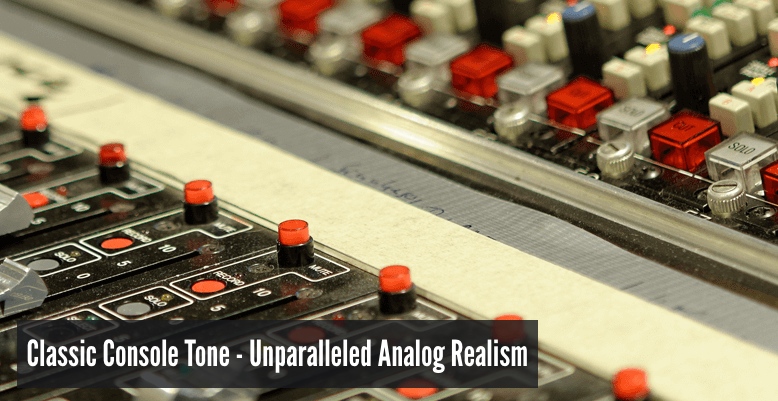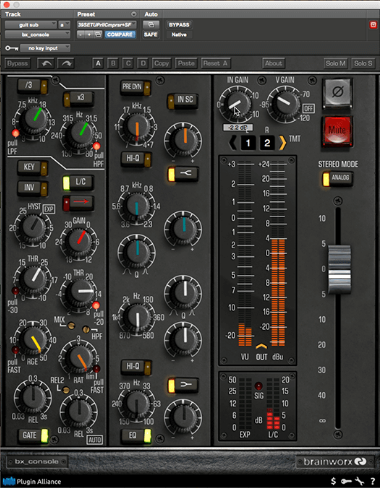New Software Review: bx_console by Brainworx and Plugin Alliance
Debates over the sound quality of digital vs. analog may be nothing new, but with bx_console, Brainworx and Plugin Alliance have taken a novel approach to bridging the divide.
With this fully-featured, one-stop channel strip, they’ve attempted to address some of the underlying physics that separate the two formats, finding new ways to bring some analog randomness to an otherwise cold, calculating and predictable digital world.
What exactly is it that makes some of us prefer the sound of large format analog consoles over digital consoles? One theory is that the natural variation between channels plays some role.
The Big Idea
Imagine a section of violinists all playing the same exact note. Much like we would expect to hear small variances in performance and tone from player to player and instrument to instrument, such is the case in the world of analog electronic components.
Although the note each violinist plays may be the same, each individual instrument imparts its unique timbre to that pitch. This in turn adds a certain richness and complexity to the overall sound, and the same basic idea can be applied to the sound of analog electronics. Just like each stringed instrument helps create a subtle variation in tone, electronic components impart their unique sound on a passing signal.
The components which make up a console’s channel strip are all manufactured to be within a varying tolerance of a given spec, and electrical engineers work hard to make them match as closely as possible. But these slight variations between each channel are part of the charm of an analog console, and to the listener, these subtle differences in tolerance can create a sense of excitement by adding more dimension to the overall sound.
Plugin Alliance implements this idea with their Tolerance Modeling Technology (TMT) in bx_console. Using a rare Neve VXS console (originally installed at Skywalker Ranch) as a benchmark, Plugin Alliance has applied TMT in their digital re-creation of this classic desk.
This particular console has a deep history: Aside from being used in many big studio film scores, it later became the centerpiece for the studio of a former member of ABBA, where it saw heavy record production duties. The console now resides at Plugin Alliance’s studio, where it has been meticulously surveyed for the purposes of creating the bx_console plug-in.
Features and Use
Above the meters in the Output section of bx_console, you will find a number for each channel, along with left & right arrows for navigation between your channels. Each number represents a unique individual channel that was modeled for this plug-in.
As you scroll through the numbers, the TMT technology applies variances to the plugin that correlate to over 150 components within the Neve VXS’s analog channels. There are 72 different channels available to choose from, and each one imparts a subtle variation on the base tone of this channel trip.
By using multiple unique instances across my mix, I quickly heard the unmistakable sound of a large-format mixing console become part of the mix. Initially, I applied this to a drum kit that I had previously mixed, replacing all the plug-ins I originally used. The effect was instantly evident as the sound took on a sense of richness and depth that wasn’t present when each channel had the same sonic characteristics.
After dialing in my bass sound, I scrolled through various channel options and became excited by having the ability to find the channel that fit the part. While subtle, it was obvious that channel selection made the difference in getting the bass to sit just right.

bx_console brings the user new levels of unique analog modeling by recreating the subtle differences in electronic components from channel to channel, as seen in real analog desks.
In terms of emulating the coveted Neve sound, I feel that Plugin Alliance has done a good job.
I first dove in to using the plug-in with no background information whatsoever; I just loaded it up and got to work. My initial reaction was that bx_console had the sound of a post 80-series Neve—and this was just after having worked on a Neve 88R for a week.
As for the layout of the channel, it will be instantly comfortable for experienced Neve users, with some added features.
The first stage the signal hits is the input section at the upper right, where you’ll find one knob for input gain, and another labeled VGain (Virtual Gain) which lets you dial in noise as desired, for an even more authentic analog sound.
After the input stage come the filters, both low and high pass. bx_console features an expanded frequency range compared to the original Neve console. The knobs are marked 7.5k-18k for the low pass filter and 315hz-31.5hz for the high pass. Further expanding those ranges, the LPF has a /3 button to divide the selected frequency by three, while the HPF has a x3 button!
Immediately following the filters you will find the dynamics section. Laid out in usual Neve format, the expander/gate is located on the left while the compressor/limiter is on the right. Visual displays for both are located under the meters in the output section. There are on/off switches for each element, and both the expander/gate and the compressor/limiter proved to be extremely flexible and easy to use.
One not-so-intuitive feature is the variable “Hysteresis” knob, which requires a little knowledge going in. Once you understand the concept, you will find it to be a powerful tool in dialing in your expander/gate. There are also buttons for keying the expander/gate as well as an “INV” button for ducking.
The compressor/limiter features a link button, allowing all the compressors in a given instance to be chained together.
Two additional features that I found helpful are set screw-style adjustments for “mix” (for in-channel parallel compression) and a dedicated high pass filter assigned to the side chain. These features are not found on the original console.
One original feature that was retained is a secondary threshold (based on the original threshold set by the user) that slows the recovery rate for quieter signals. This makes for a smoother response, virtually eliminating “pumping” sounds created by the compressor. Plugin Alliance has now made this feature accessible by way of set screw.
The equalizer—like its hardware counterpart—is quite flexible and can be used in a variety of ways. The layout features fully parametric high-mid and low-mid EQ’s alongside semi-parametric high and low sections as well. Either of these semi-parametric sections can be set to high Q or shelf for added flexibility.
Unlike the original console, the EQ section may be assigned pre-dynamics if desired. This gives you a much wider range of sonic options, as the compressor will react differently to a signal pre- and post-EQ. Lastly, the EQ section can be assigned to the sidechain of the Dynamics section, giving you even further control over the processing of your signal.
In addition to the input controls, the Output section also features a VCA fader to adjust your signal level post-processing. You’ll also find a “Mute” button on the plug-in, which may be redundant but adds to the authenticity.
The metering shows both VU and dBu for either the input or output, as well as the aforementioned dynamic section meters, where the signal light now becomes an overload indicator.
There is also a “Stereo Mode” button which toggles stereo instances between analog and digital modes.
In analog mode, the stereo set features two different numbered faders while digital gives you two copies of the same channel. I tried this on bass, which was printed in stereo. In analog mode, this produced a wider sounding image as the slight differences between channels acted like a subtle chorusing effect. In digital mode, the sound was more focused and not quite as wide to my ear.
The toolbar offers buttons for Bypass, Undo, and Redo, as well as buttons A-D for storing presets. Copy and Paste buttons enable you to move your presets around.
To Be Critical
There are buttons to solo the mid and the sides separately, however the manual doesn’t discuss setting up a mid-side matrix. Another small gripe here is that the plug-in opens with all sections engaged, whereas I prefer to turn on only the sections I wish to utilize.
Summing it Up
It is clear that this one channel strip plug-in provides serious amounts of processing power. While I will still use my go-to signal chains for select tracks, the ability to have so much processing immediately available will greatly speed up my workflow!
Plugin Alliance’s TMT processing undoubtedly introduces a richness of texture that has been lacking “in-the-box”, and I’m happy to see that some of my major issues with mixing digitally have now been addressed.
Rick Slater is an audio professional who lives, works, and educates in the New York City area.
Please note: When you buy products through links on this page, we may earn an affiliate commission.







